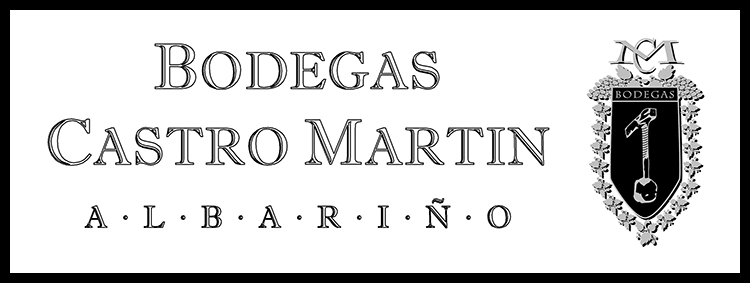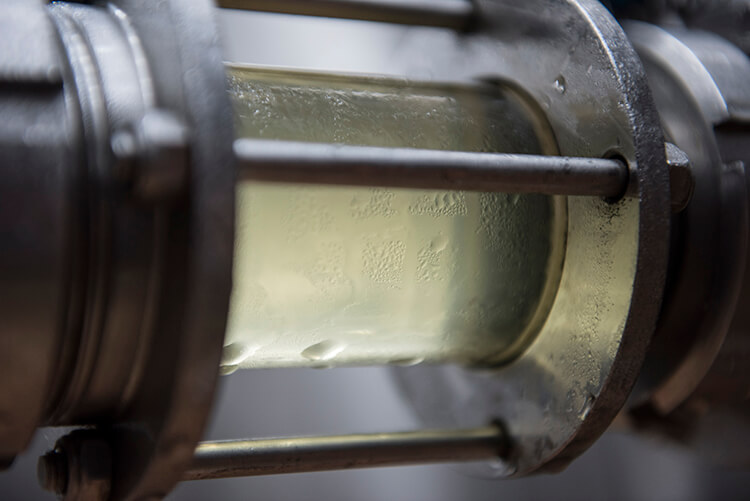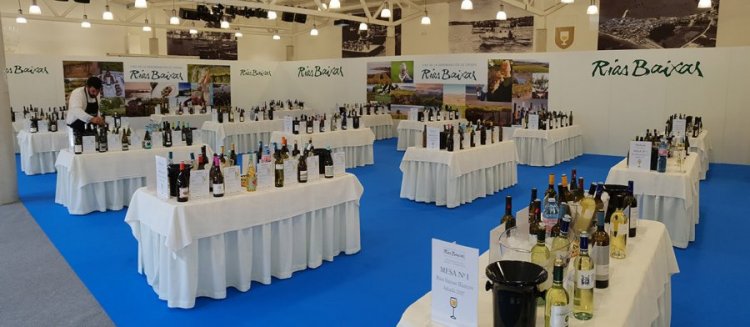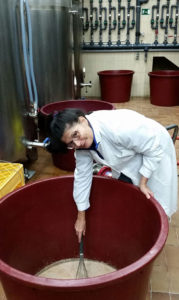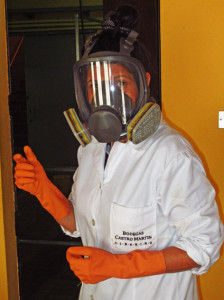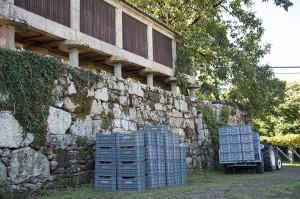 Suffice to say that today’s weather is still fine and sunny, and with all set fair we started our presses earlier than ever. The first load was under way at shortly after 11am, which is just about as early as we can manage. The picking team swoop in at 9.30am (once the fruit has lost any overnight humidity), they load their 20kg baskets, and these are whisked away without any delay to the bodega – a perfect start to the day, until…… Yes, the inevitable technical problem, but this year not one that we would normally anticipate. The large industrial scale that we use for weighing the pallets of grapes as they are unloaded, decided to start giving us completely nonsensical readings – for example, according to the system I now weigh minus 3kg (the new diet must be working better than I thought!). This weighing system is connected directly to the computer that checks in every single load, and whilst we could read the sugar, the pH and the acidity, the weight of each basket remained a total mystery. Time to call the engineer and wait for a response.
Suffice to say that today’s weather is still fine and sunny, and with all set fair we started our presses earlier than ever. The first load was under way at shortly after 11am, which is just about as early as we can manage. The picking team swoop in at 9.30am (once the fruit has lost any overnight humidity), they load their 20kg baskets, and these are whisked away without any delay to the bodega – a perfect start to the day, until…… Yes, the inevitable technical problem, but this year not one that we would normally anticipate. The large industrial scale that we use for weighing the pallets of grapes as they are unloaded, decided to start giving us completely nonsensical readings – for example, according to the system I now weigh minus 3kg (the new diet must be working better than I thought!). This weighing system is connected directly to the computer that checks in every single load, and whilst we could read the sugar, the pH and the acidity, the weight of each basket remained a total mystery. Time to call the engineer and wait for a response.
Of course the inevitable result of any such delay is the dreaded backlog – once the pressing process is stopped at any point whilst the grapes are still arriving then things, quite literally, begin to pile up. Thankfully the engineer responded pretty quickly, and within a couple of hours we were back up and running. The grape reception area needed some sorting out as the pallets were lined up for weighing, but eventually order was restored, and we carried on on our cool, calm and collected way….. (well, that last part might be a bit of an exaggeration).
To end the day Angela had one minor disaster of her own – preparing some tank treatments in the laboratory her Blackberry slipped out of the breast pocket of her white coat and landed straight in a bucket of sugary grape must – I think that’s what you have to classify a ‘sticky end’, but if you could chose, I guess it’s not such a bad way to end your working life!
 Suffice to say that today’s weather is still fine and sunny, and with all set fair we started our presses earlier than ever. The first load was under way at shortly after 11am, which is just about as early as we can manage. The picking team swoop in at 9.30am (once the fruit has lost any overnight humidity), they load their 20kg baskets, and these are whisked away without any delay to the bodega – a perfect start to the day, until…… Yes, the inevitable technical problem, but this year not one that we would normally anticipate. The large industrial scale that we use for weighing the pallets of grapes as they are unloaded, decided to start giving us completely nonsensical readings – for example, according to the system I now weigh minus 3kg (the new diet must be working better than I thought!). This weighing system is connected directly to the computer that checks in every single load, and whilst we could read the sugar, the pH and the acidity, the weight of each basket remained a total mystery. Time to call the engineer and wait for a response.
Suffice to say that today’s weather is still fine and sunny, and with all set fair we started our presses earlier than ever. The first load was under way at shortly after 11am, which is just about as early as we can manage. The picking team swoop in at 9.30am (once the fruit has lost any overnight humidity), they load their 20kg baskets, and these are whisked away without any delay to the bodega – a perfect start to the day, until…… Yes, the inevitable technical problem, but this year not one that we would normally anticipate. The large industrial scale that we use for weighing the pallets of grapes as they are unloaded, decided to start giving us completely nonsensical readings – for example, according to the system I now weigh minus 3kg (the new diet must be working better than I thought!). This weighing system is connected directly to the computer that checks in every single load, and whilst we could read the sugar, the pH and the acidity, the weight of each basket remained a total mystery. Time to call the engineer and wait for a response.
Of course the inevitable result of any such delay is the dreaded backlog – once the pressing process is stopped at any point whilst the grapes are still arriving then things, quite literally, begin to pile up. Thankfully the engineer responded pretty quickly, and within a couple of hours we were back up and running. The grape reception area needed some sorting out as the pallets were lined up for weighing, but eventually order was restored, and we carried on on our cool, calm and collected way….. (well, that last part might be a bit of an exaggeration).
To end the day Angela had one minor disaster of her own – preparing some tank treatments in the laboratory her Blackberry slipped out of the breast pocket of her white coat and landed straight in a bucket of sugary grape must – I think that’s what you have to classify a ‘sticky end’, but if you could chose, I guess it’s not such a bad way to end your working life!





